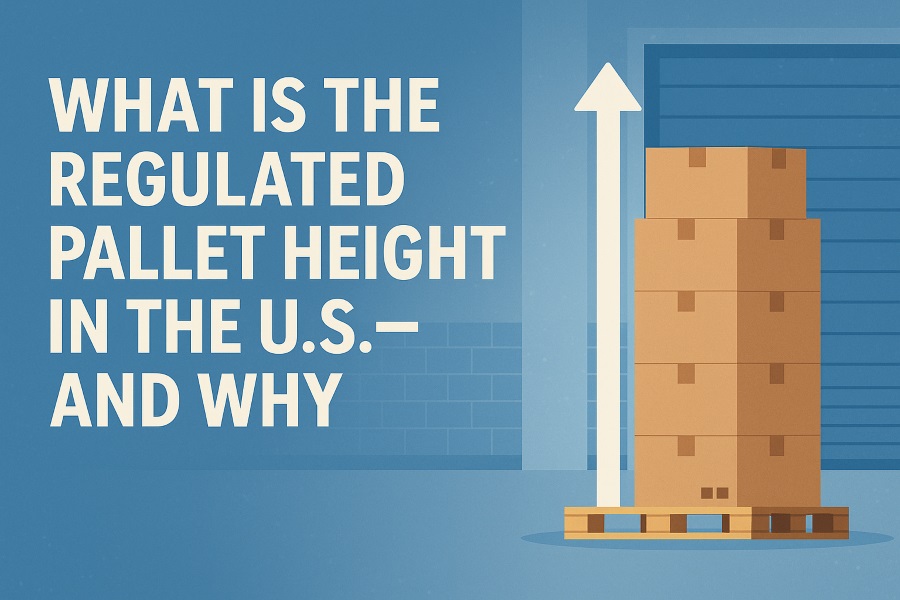What Is the Regulated Pallet Height in the U.S. – And Why It Matters?
By Royal Foods Distribution
In the world of logistics, the smallest details can have the biggest impact. One such detail – often overlooked by shippers and receivers – is regulated pallet height. While the dimensions of a standard pallet might seem straightforward, the total height of a fully loaded pallet plays a critical role. In fact, it determines how goods move efficiently, safely, and compliantly through the supply chain.
At Royal Foods Distribution, we handle cold storage and drayage for many regulated goods. Managing pallet height regulations is part of our daily operation. So, what exactly is the standard or regulated pallet height in the U.S., and why is it regulated the way it is?
What Is the Regulated Pallet Height?
In the United States, the most commonly used pallet is the GMA (Grocery Manufacturers Association) standard pallet, which measures 48 inches long by 40 inches wide. The pallet base itself typically measures about 5 to 6 inches in height. However, the overall regulated pallet height, including the load, is often limited to between 48 and 72 inches. This depends on the carrier, warehouse configuration, and product type.
In many warehouse and freight environments, a maximum pallet height of 60 to 72 inches (including the pallet) is the accepted norm. However, some cold storage facilities, like Royal Foods, may establish specific limits based on racking design, forklift clearances, and regulatory guidelines.
Why Is Regulated Pallet Height Important for Compliance?
Pallet height is not regulated arbitrarily. There are clear safety, efficiency, and compliance reasons behind it – that explain why a pallet height limit is essential across industries.
- Maximizing Storage Space
In warehousing, every inch counts. Standardizing pallet height helps maximize vertical storage space, ensuring that staff can use racking systems Products are inspected effectively without risking damage to product or infrastructure. Especially for refrigerated or frozen goods, where cold air flow is essential, proper pallet height also ensures consistent temperature distribution.
- Ensuring Load Stability
Additionally, tall or irregularly stacked pallets are more likely to become unstable during transport or handling. By capping pallet height, carries reduce the risk of tipping, shifting, or collapse, all of which can cause product loss or injury.
- Compatibility With Equipment
Forklifts, pallet jacks, and conveyor systems are designed with specific clearance tolerances. A pallet stacked above the regulated height can become unmanageable or cause equipment malfunctions, delays, or even safety hazards.
- Compliance With Transportation Standards
Truck trailers, shipping containers, and air cargo units have limited headroom. For example, a standard 53-foot dry van trailer has an interior height of approximately 110 inches. If pallets are stacked too high, they may not fit in the trailer – or worse, they might shift in transit, risking a rejected shipment or costly freight claims.
For cold chain shipments, compliance becomes even more critical. Many USDA – and FDA regulated products are inspected during transport or upon arrival. Improper stacking or over-height pallets can trigger non-compliance, rejection, or rework. At Royal Foods, we actively monitor pallet configuration to prevent such issues.
At Royal Foods Distribution, we specialize in cold storage, cross-docking, or USDA-compliant handling. We understand the importance of adhering to regulated pallet height requirements for safe, efficient, and compliant shipments. If you need help managing compliance for palletized cold storage shipments, contact Royal Foods. Our team is here to ensure your products move seamlessly through the supply chain.
Contact Royal Foods – Cold Chain Logistics Experts
Royal Foods Distribution
2026 Martin Ave, Santa Clara, CA 95050
📞 Phone: (408) 560-1628 or (408) 368-0408
📧 Email: info@royalfoodsdistribution.com
🌐 Website: www.royalfoodsdistribution.com

